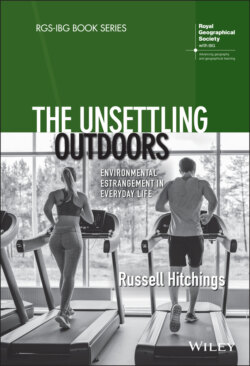Читать книгу The Unsettling Outdoors - Russell Hitchings - Страница 18
Establishing a Focus
ОглавлениеThe above discussion has covered what this book will attempt to do, why that could be a worthwhile undertaking, and the ideas on which it draws. Based on that, these are the basic ingredients for the approach being developed here:
1. Environmental estrangement From the existing research on greenspace benefits a number of ideas have been taken. First, the whole rationale for this book is derived from one of the essential findings of this field, namely that spending time in the company of trees and plants can provide people with a diversity of benefits, from mental restoration, to lowered blood pressure, to reduced stress and greater feelings of self-esteem. And, more than that, this might then even spill over into a broader sense of care for the living environment at a time when encouraging such commitments might be more important than ever. This work also suggested that many urban lives were, despite all these potential benefits, now unlikely to involve so much time outside with plants and trees. A variety of potential explanations were offered for this. Less had, however, been said about how a kind of environmental estrangement might be observed and examined in everyday life.
2. The everyday outdoors Meanwhile, in human geography, I found an eagerness to examine how exactly different groups lived with the ‘natural world’ and an interest in seeing social life as a negotiation with physical phenomena. These ideas have informed my focus on the everyday outdoors. Here I will partly follow their lead by paying particular attention to the specifics of the situations at hand and exploring how the various ‘natural’ materials involved are managed differently according to those specifics. The ‘outdoors’ commonly figures as a self-evident, unremarkable background feature of life. My aim here is partly to turn the tables on this situation by considering how the ‘outdoors’ is home to a whole raft of phenomena – living plants, changeable weather, different kinds of dirt – that deserve examination. This is what greenspace experience often involves, after all, and we should examine how these phenomena are allowed to complicate human lives at a time when the assumption that people are best kept away from them is often quietly gaining ground.
3. Unsettling practices Yet, just as some of my geography colleagues were seeking out and celebrating the capacities of various creatures and forces that were previously swept under the social science carpet, I also wanted to examine how people can be recruited into the reproduction of everyday practices in ways that meant these same capacities might fade into the background of their lives. So I turned to concepts of ‘social practice’ because they promised an appreciation of how the ‘extinction of experience’ was practically achieved in ways that the people involved might only be partly aware of. The key idea that I wanted to take forward from this work was therefore about seeing society as comprising practices that can recruit people in ways that, as we will see, might effectively act to distance them from certain beneficial outdoor experiences. In this regard, the value of these concepts stems from how they highlight the subtleties of these processes in which relevant groups figure as sometimes able to question, and potentially amend, their actions, and sometimes effectively controlled by the practices that live through them. In that respect, I wanted to examine how, in different contexts, a range of potentially unsettling environments were handled – when and how do people submit to the practice? And when and how might they struggle free in ways that take them towards a fuller relationship with the outdoors?
